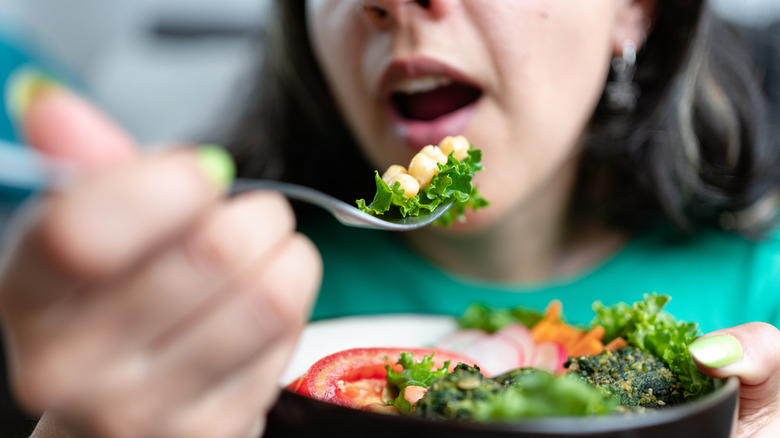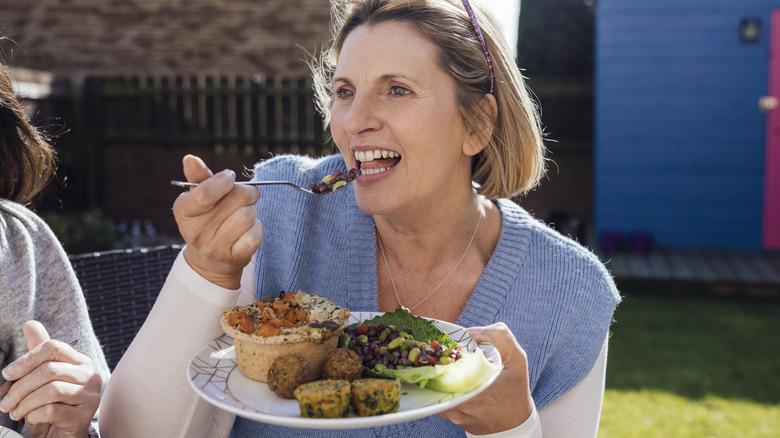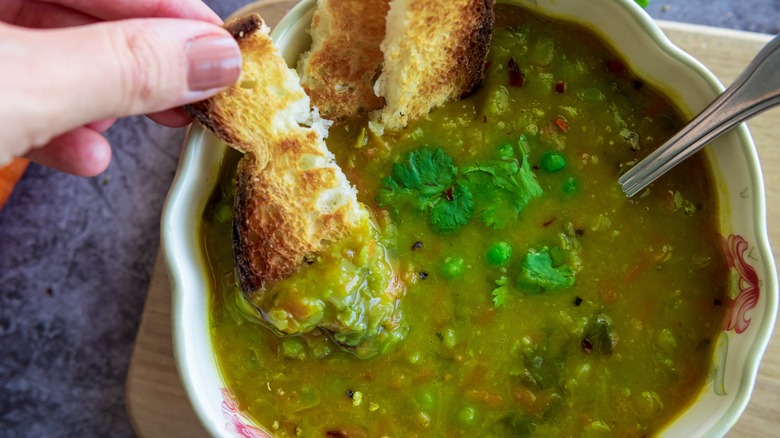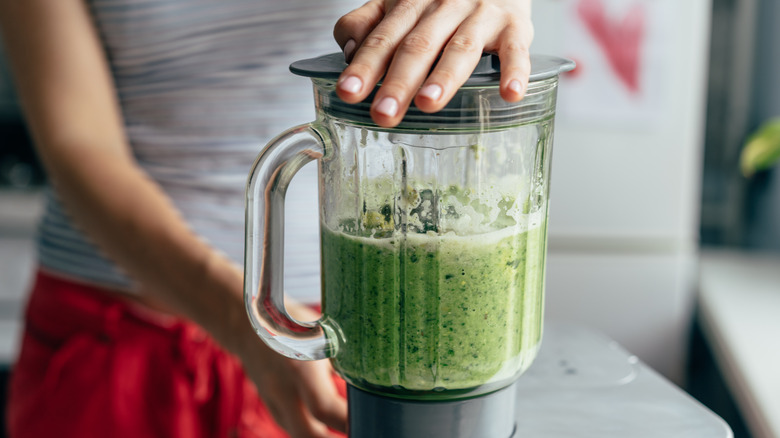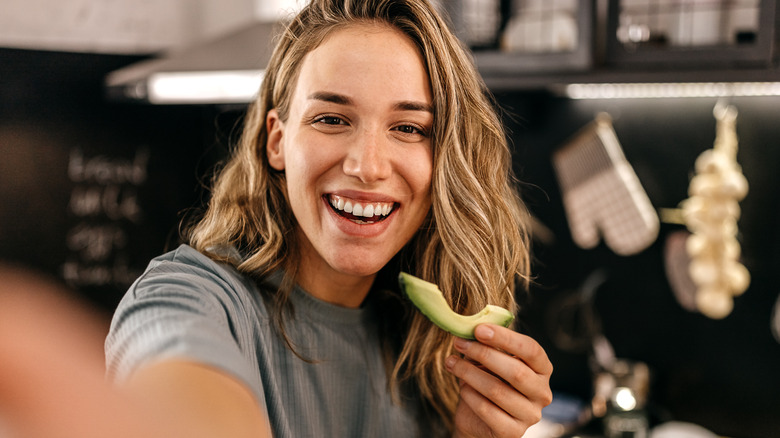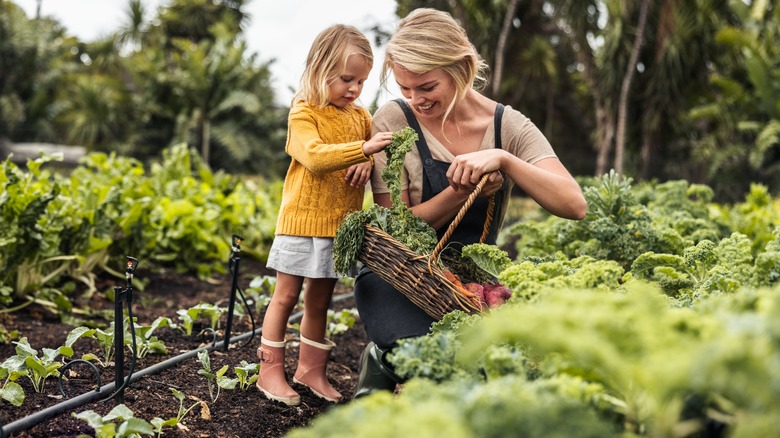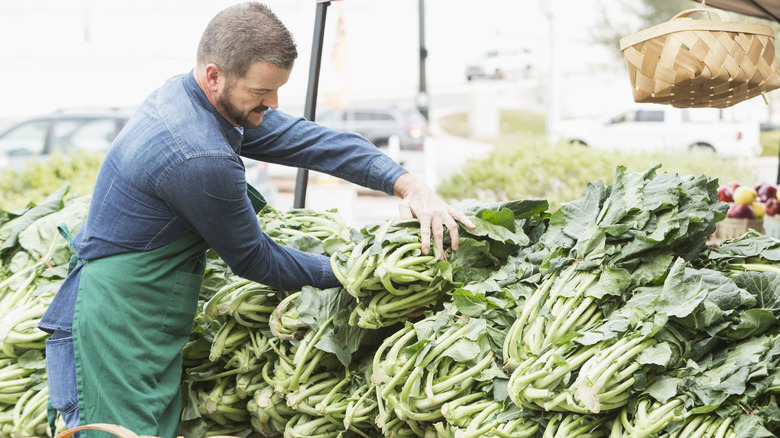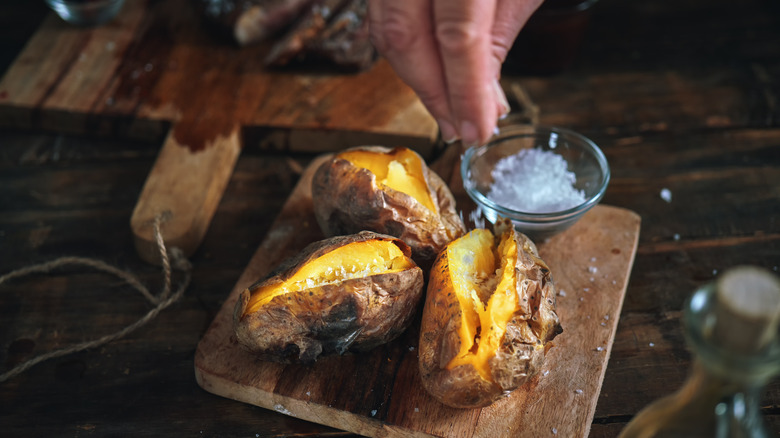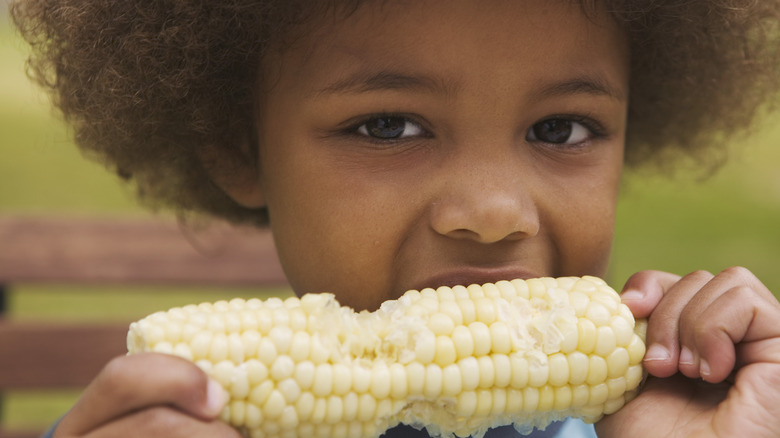Vegetables That Are Higher In Protein Than Meat
You know it's vital to get enough protein in your diet. It's all over the internet, TV, and dietitian pamphlets. It's an essential nutrient for every function in your body, especially your muscles and bones. Just look at how bodybuilders promote those protein shakes to get those defined muscles.
However, adding more protein to your diet doesn't mean you need to pack more beef, chicken, eggs, and fish into it. Vegetables are also a good source of protein for those looking to cut out meat. While many vegetables don't sport the highest protein levels, a few leafy greens, legumes, and tubers stand out among the crowd. In fact, some of them could give you more protein than meat if you were to eat the same amount of calories. There are even some protein-powerhouse legumes that can compete with your favorite red meat or poultry by just adding a cup to your plate.
Prepare to add vegetables with more protein than meat to your plate and your diet. Here are some of the multiple health benefits of packing these protein-rich veggies into your lunchbox.
Check out the protein in chickpeas
Chickpeas, also known as garbanzo beans, might bring pita crackers and your favorite hummus flavor to mind. But these nutritional ninjas pack a lot of nutrition into all that flavor. Coming in at 14.5 grams of protein for each cup, they are a complete protein. And as dietitian Patricia Bridget Lane told Cleveland Clinic, they are "an excellent source of non-animal protein."
This legume is also reaping the rewards on the fiber scale, so it's good for helping to keep your weight under control by keeping you feeling full and everything running smoothly in your gut. They are also rich in the good fats that your body requires to keep your cells moving and your heart pumping, in addition to having a low glycemic index. According to Harvard University, anemia sufferers can also get extra iron added to their diet.
Hummus is a wonderful way to add a heart-healthy snack to your diet, but it's far from the only way to eat chickpeas. You can roast them in an air fryer to give your salad more crunch or pile them on your sweet potato. You might even want to try an easy chickpea salad sandwich.
Eat more edamame
Packing protein into your diet isn't as complicated as you think when you remove meat. Several legumes are protein-loaded and easy to add to a meal. Another legume to top the charts of protein-powered veggies is edamame, which is a kind of soybean. According to the USDA, every cup of edamame increases your daily protein consumption by 13.2 grams.
While you may not recall hearing about edamame, you've probably consumed it in a Japanese or Chinese restaurant. These green beans have been included in Asian diets for thousands of years, per Food Print. And you'll certainly want to add them to your diet, too, because edamame is considered a complete protein. Emma Newell, RD, LDN, told Real Simple, "This means that it contains all nine essential amino acids, which is great for vegetarians and vegans, as it can be difficult to find plant-based options that are complete protein sources." In addition to that protein punch, edamame is rich in fiber and omega-3s to benefit your heart.
Try adding edamame into your diet by pairing them with an excellent pasta. They can also give your salad an extra kick of flavor.
Sautee some split peas
Your parents have probably been telling you to eat your peas for most of your life. And there's a good reason: peas are good for you, plain and simple.
When it comes to protein, split peas are packed with it, boasting 45.3 grams per cup, per the USDA. These little beans are rich in more than just protein; you'll also up your intake of iron, phosphorus, and zinc, according to NutritionFacts.org. And as Healthline notes, split peas also have a bit of phytic acid, which might help reduce the risk of colon cancer.
Split peas might seem like they don't make it beyond split pea soup, but they can actually be added to various dishes. For example, you might try sprinkling them on a salad for extra protein. They can also be mashed into dips or added to other kinds of soup.You can even fill your plate with green and yellow varieties to add a bit of color.
Bulk up on black beans
Black beans are high in fiber and have a good amount of protein at seven grams per half cup, stated Prevention. As registered dietitian Tessa Nguyen explains, black beans are "an inexpensive, accessible, and culturally diverse food that serves up long-lasting carbohydrates, fiber, protein, and healthy fats."
Fiber is an excellent thing to add to any diet because it can make you feel full. Clean Eating notes that black beans can help control your weight. This also means your guts will be healthier as the fiber bulks up your waste. Additionally, black beans contain flavonoids. A 2019 study in Antioxidants showed that flavonoids can be helpful in the treatment of chronic inflammation.
Black beans can work as the perfect meat substitute to bring the calories of your dish down. They can also be added to everything from salads to soups for a bit more flavor. You might even want to try this heart-healthy black bean soup recipe.
Load up on lentils
Lentils are a type of legume that's been around for ages. Packing in a nice 12 grams of protein into a half cup, the history of lentils goes back to 8,000 BC in the Middle East, according to WebMD.
Beyond adding protein, these little beans are filled with fiber and minerals like potassium, folate, and iron to keep your heart and cardiovascular system running at their best. And you have a bit of variety when adding lentils to your plate since you can buy brown, green, red, and yellow lentils at the market, per Healthline.
The only downside to lentils is that they need a bit of water to allow your gut to break down all that goodness. Therefore, you'll want to boil them for at least 30 minutes to tenderize them. After cooking, you can substitute them for meat to make some tasty lentil tacos, or perhaps a sumptuous lentil soup.
Spare some time for spinach
The word protein doesn't usually make you think of leafy greens like spinach. But this green bit of roughage has a nice helping of protein at 5.35 in a cup of cooked spinach, according to the University of Rochester Medical Center. Now, that might not seem like too much, but a slice of bacon only has about four grams of protein, and it's much less filling.
In addition to nourishing your cells with some much-needed muscle builder, Medical News Today notes that spinach is high in several different vitamins like calcium, magnesium, and iron, which promote nerve function, bone health, and oxygen-rich blood. Additionally, spinach is one of the foods you'll want to turn if you need to add more fiber to your diet to help relieve constipation and promote a healthy gut. It also offers a healthy dose of vitamins A and C to keep your immune system running at its best.
With that said, just because spinach is nutritious doesn't mean it's delicious for everyone. Thankfully, you can find creative ways to sneak it into your next snack by trying it in a smoothie, adding it to soup, or stuffing it in your enchiladas. Consider adding a little spinach to your lasagna by trying butternut squash and spinach lasagna.
Add some artichokes to your plate
When it comes to vegetables, artichoke tends to be on the more exotic side of things. After all, it's not something you commonly throw on the grill with your green peppers and onions. Don't let that stop you from adding artichokes to your diet, though, as 128 grams of this green wonder have four grams of protein packed into them (via WebMD).
Many vegetables have histories that go back thousands of years, but interestingly, the artichoke is found in Greek mythology. As the story goes, artichokes were created by Zeus during one of his many romantic entanglements (per the University of Wyoming). The artichoke's heart and leaves are packed with delectable goodness and are known to improve blood pressure and liver health. WebMD also notes that artichokes are good for helping to lower cholesterol levels when taking the leaf extract.
Since fresh artichokes can be hard to peel, most people use canned or frozen artichoke hearts to add to their meals. These versatile vegetables can also be baked in olive oil, grilled, added to pasta, or even stuffed.
Advantages of avocado
Lovers of all things guacamole might find it shocking that this lovely green veggie made into their favorite dip also has a nice amount of protein. While it's not coming in as high as legumes, at four grams for a seven-ounce avocado, it will give you a nice protein bump (via Healthline). But avocados aren't just protein-rich vegetables; they're also rich in good fats and help you digest and absorb beta-carotene. That's why pairing avocado and carrots is a good idea.
Fats can get a bad rap, even the so-called "healthy" ones. With that said, avocados can benefit your heart because beta-sitosterol is known to help keep you at healthy cholesterol levels, states Medical News Today. A 2017 study in Nutrients showed that consuming avocados was good for increasing the lutein in your body and helping with cognition. Researchers also say avocado consumption helps with depression and supports healthy body weight.
Add avocado to your toast or salad to get a healthy dose of fiber and a bit of protein. You might even use it as a whip for creating a more nutritious tuna or chicken salad sandwich.
Bring on the Brussels sprouts
It can be hard not to associate Brussels sprouts with every parent in the world trying to persuade their child to eat them. While the younger crowd might have some negative feelings about Brussels sprouts, keeping them on your plate can add some serious veggie protein to your diet. Like their cruciferous cousins, broccoli and cauliflower, Brussels sprouts are packed with vitamins and minerals. WebMD notes that a cup of cooked sprouts had four grams of protein.
While this vegetable might be common on many American plates, it was discovered in Belgium in the 16th century (which explains the name). In addition to having a good helping of vitamins C and K, these sprouts are rich in calcium, folate, and iron. It takes a bit of practice, but when you cook them just right, they can taste sweet and nutty. Remember, though, that they can easily turn bitter if overcooked.
With that said, don't let the taste deter you, because in addition to their nutritional content, Brussels sprouts can help protect you against cancer. According to the University of Texas MD Anderson Cancer Center, Brussels sprouts have sulforaphane phytochemicals that can neutralize toxins, reduce inflammation, protect DNA, and even slow cancer growth.
Craving a bit of kale
You might not think of crunching on kale as a good time, but adding more of it to your diet is beneficial, and not just in terms of your protein requirements. Kale is a super green that pairs with salads or blends into juices perfectly. You might also want to add kale to your dips rather than spinach (or go wild and use both). Plus, they make great chips when you bake and season them.
The University of Rochester Medical Center lists one cup of cooked kale as having 3.62 grams of protein. That might not seem like a lot, but given how you can add it to your food, it will pile up fast. In addition to having a low caloric density, kale is loaded with antioxidants (via Healthline). Filling up on antioxidant-rich food is good because they keep free radicals in the body at bay, protecting the cells from stress, according to a 2020 publication in the Journal of Food Biochemistry.
Cover your plate with collard greens
Collard greens are more than just a Southern favorite. In an interview (via Food Print), food historian Michael Twitty said, "Collards are not African, they are temperate, and Eurasian in origin, but their consumption, and with them — turnip, kale, mustard, and other greens are a healthy blend of tastes — West and Central African, Scottish, Portuguese, German and the like." Rich in nutrients like their cabbage cousins, collard greens bring various health benefits and some protein, with My Food Data listing 5.1 grams of protein for one cooked cup.
Protein aside, you can find several unexpected benefits of collard greens, like improving bone health, notes Medical News Today. These leafy greens are potent in vitamin K, which helps calcium absorption. Beyond just your bones, research found you can lower your risk for cancers by eating cruciferous vegetables (via Molecular Cancer). They might even help you sleep better due to the choline content, according to Prevention.
You can find several comfort food recipes for getting collard greens onto your plate, but adding this portion of veggies doesn't mean you need to become a culinary master. Simply add some raw collard greens to a wrap. It's also tasty when you mix them into your newest stir-fry creation.
Pack your plate with potatoes
Grabbing a plate of steak and potatoes isn't just going to give you protein from the meat. Surprisingly, the potatoes have protein in them — at three grams in a medium potato, according to Washington Potatoes. Like red meat, potatoes have gotten a bad reputation over the years due to the amount of starch they contain, but they are nutritious and healthy when eaten in moderation.
Potatoes come in all different types, including red, russet, sweet, and purple potatoes. Depending on the type of potato you try, they can have different health benefits, like being rich in vitamins A and C. While potatoes have more starch and less fiber than your friendly kale, they are still rich in minerals and antioxidants, per the University of California – Davis.
Now, you might think French fries aren't healthy, but that doesn't make all potatoes bad for you. Typically, it comes down to how you cook your potatoes; boiled and baked potatoes can be filling and tasty to treat. You can even try air-frying your own potato chips to get that satisfying crunch.
Satisfy your tastebuds with sweet corn
You know that summertime has come when you start seeing those sweet corn stands popping up. That delicious yellow gold cob, roasted and slathered with a bit of butter or rolled in your favorite seasonings, is the thing dreams are made of. But in addition to being a great summer snack, sweet corn also packs more protein than bacon at 4.3 grams in one cup, according to the University of Rochester.
Corn is a versatile food that can be creamed, boiled, grilled, steamed, and microwaved. It's fun to add to any salad, soup, or even warm chili, and can even be made into bread. You might also want to try your hand at making savory corn chowder. Beyond just being delicious, sweet corn is a low-fat food, filled with good fats that are beneficial to your heart health. Mayo Clinic also notes that corn is a low-glycemic index food, and is a good source of vitamin B, zinc, and magnesium.


